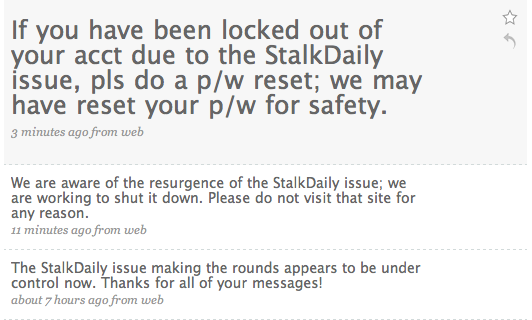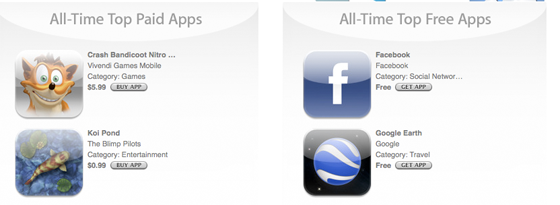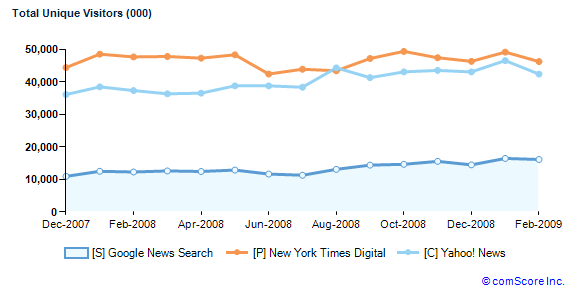The Latest from TechCrunch |  |
| Some Of Our Favorite Easter Eggs Posted: 12 Apr 2009 02:00 AM PDT
Just as children love hunting for Easter eggs, we love finding virtual Easter eggs in software and Web apps—those intentional hidden messages, features or jokes built into the software that users in the know may stumble upon at some point during their experience with the application. We’ve compiled a list of some of our favorite software Easter eggs of all-time (in no given order) in light of today’s holiday. Of course, there are many more Easter eggs out there. Tell us us your favorites in the comments! 1. Atari: The first ever software Easter egg is speculated to have occurred in 1979 in an Atari game. Apparently, programmer identities were kept behind locked doors in the easly days of software development, with companies not wanting staff to gain more celebrity status than their brands. Warren Robinett, a programmer for Atari sneaked his name into the Atari 2600 game Adventure. Here’s the YouTube video showing the egg:
2. Google’s Picasa Teddy Bears: Image editing software Picasa has an entertaining teddy bear Easter egg. If you open Picasa and press Ctrl-Shift-Y, a teddy bear will pop up. 3. The Book of Mozilla: If you type “about:mozilla” in the address bar of any version of Firefox, you will be led to a page with a quote from the “Book of Mozilla” about the birth of Firefox. 4. Google Earth Flight Simulator: If you open Google Earth, version 4.2, and press Ctrl-Alt-A (”Command” “Option” “A” on a Mac), Google inserted a flight simulator that lets you simulate being in the cockpit of a F16 fighter jet ot a lightweight SR22 propeller plane. 5. The Dark Castle on the iPhone/iPod Touch: According to this report, a teenager in the UK managed to discover this egg, the classic Mac game "Dark Castle", in its entirety, available on the iPhone and iPod Touch. Activating this game is a bit complicated but, here are the directions.
6. Google’s Mobile App: Google unveiled a surprise Easter egg for its Mobile App for the iPhone earlier this year. If you click on the settings tab, scroll to the bottom and keep swiping upwards until a secret option dubbed 'Bells and Whistles' appears (this also works in the foreign language versions of the app). The hidden menu lets you change the theme color of the app and its default sounds to chicken or monkey noises. 7. Microsoft’s Volcano: Microsoft inserted a volcano Easter egg in all Windows Operating Systems prior to XP. If you go to control panel display, click on the screen savers tab, select “3D Text,” then click on settings and in the graphics text box type “volcano.” The screen saver then shows names of all the volcanoes in the U.S.
8. Google’s holiday Easter eggs: Last holiday season, Google put Easter Eggs next to the sponsored link search results for terms like Christmas, Hanukkah, Kwanzaa Gifts, Christmas Sweaters, Hanukkah Sweaters, etc. 9. Mac OS X “Here's to the Crazy Ones”: If you open Finder and go to Applications, look for TextEdit. If you enlarge the icon in CoverFlow, you'll see a letter from John Appleseed quoting the text from Apple's "Think Different" advertising campaign. 10. Goldeneye Breakdance: This egg was recently discovered. Apparently when playing Goldeneye 007, if the user tilts the cartridge during gameplay, this causes the characters to breakdance. It’s pretty funny-see the YouTube video of the dance below: Crunch Network: CrunchBase the free database of technology companies, people, and investors |
| Does Google Really Control The News? Posted: 11 Apr 2009 09:19 PM PDT
Once again, Google is the favorite bogeyman responsible for the rapid deterioration in the health of the news industry. This time it is Nick Carr doing the finger-pointing, describing Google as the most powerful middleman in news:
So how powerful is Google when it comes to parceling out traffic to news sites? If you are talking about Google News, the answer is that it is not quite as powerful as you might think. In the U.S., Google News is overshadowed by both Yahoo News and even the sites controlled by the New York Times (which includes NYTimes.com, Boston.com, HeraldTribune.com, and several other newspaper sites). According to comScore, Google News attracted 16.2 million unique visitors in the U.S. in February, compared to 42.3 million for Yahoo News and 46.2 million for the sites operated by New York Times Digital. So Google News is not the middleman here. Let’s just put that notion to rest. Yahoo News is three times as large, and Yahoo sends even more traffic to newspaper sites from other parts of Yahoo through its online newspaper consortium. The bigger question is whether Google as a search engine is controlling access to news sites. That really seems to be Carr’s main concern, although it is not clear because he uses a Google News search as his main example. Nevertheless, Google’s main search engine is certainly a major source of traffic to information sites of all stripes. At TechCrunch, for instance, it is the single largest source of traffic, accounting for about a third of the total. I have no idea whether this is representative of other news sites, but it wouldn’t surprise me. Google search is a very important middleman indeed. Does that make Google like Wal-Mart, as Carr suggests, a middleman of such might that it squeezes everybody else’s margins? Does that give it “monopoly control over content distribution,” as Scott Karp tries to argue? Not exactly. Information economics work slightly differently than retail economics. Let me stick with the TechCrunch example. One third is a lot, but it is not a monopoly. Google sends us all of that traffic because many of our posts rank highly for the topics they cover. We don’t pay them for that traffic. We are not buying keywords. Yes, Google makes money from other ads shown besides any searches where TechCrunch posts shows up as results. But the money Google makes from those ads does not detract from our revenues. Quite the opposite. Those searches send a considerable amount of traffic to our site, where we have our own ads. The more people who see those ads, the more we can charge for them. It’s all good. Google does not control the news, it exposes it. The retail/distributor analogy is all wrong. Information is not the same as a flat-screen TV or a blender. It does not become less valuable the more available it is because all news is not the same. Information dissemination is not a zero-sum game. Carr and Karp would have you believe otherwise. Karp writes:
Again, that is not how it works. Google doesn’t force suppliers of information to charge less for it as Wal-Mart does with suppliers of packaged goods. The money Google makes from its search ads is not necessarily money that would have otherwise gone to a “news” or content site. If Google didn’t exist, those ad dollars might have gone to an e-commerce site or a travel site or a real estate site or any number of other places. News sites have no claim to those search advertising dollars. It is incumbent upon each of us to attract an audience by having something original or interesting to say. When news sites do that, other sites link to them, and then they rank more highly in Google search results, which sends new readers their way. And then once those readers do find a news source they trust, you know what? Some of them actually keep coming back on their own volition without Google telling them what to do. That is called direct traffic. Or they come through other sites. Google isn’t the only one who benefits from all those links. If you want to be known as an authoritative source of news, it is no longer good enough to simply proclaim yourself to be one. Crunch Network: MobileCrunch Mobile Gadgets and Applications, Delivered Daily. |
| Warning: Twitter Hit By StalkDaily Worm (Updated) Posted: 11 Apr 2009 04:48 PM PDT
A bad week for Twitter just got even worse. The service has apparently been infected by a worm originating from the owners of the website StalkDaily (Note: Do not visit this website, as it may cause your computer to become infected). At this point details are scant, but it appears that visiting the Twitter profile page of an infected user can lead your profile to become infected as well (some reports say that the worm modifies your ‘About Me’ section to include a link to the worm). Infected users begin to repeatedly spam tweets directing users to the StalkDaily website. The attack appears to have originated early this morning, when a handful of blog posts popped up detailing the worm. However, it is only now hitting critical mass, with hundreds of related Tweets appearing on Twitter Search in the last few minutes alone. Twitter’s official Spam watching account updated this morning stating that the company was aware of the issue but that it had been mostly resolved, and just issued another update stating that it was aware of the worm’s resurgence this afternoon. To stay on the safe side, it would probably be wise to stick with a third party Twitter client and avoiding viewing profile pages until the company confirms that the issue is resolved. Some early comments are indicating this is an XSS attack on Twitter. Others note that the attack may have started after one of Twitter’s many third party applications took the login credentials entered by Twitter users and hijacking their accounts. Update 9 PM PST: Twitter has posted the following update to its status page stating that the issue has been fixed:
 Update: Apparently StalkDaily has updated their website to say that it has nothing to do with the attacks. Regardless, do not visit the site for the time being.
Crunch Network: CrunchBase the free database of technology companies, people, and investors |
| Apple Offers Another Fleeting Glimpse At The App Store’s All-Time Leaders Posted: 11 Apr 2009 03:50 PM PDT  This isn’t an accident. One attribute that has helped the App Store reach its upcoming billion download milestone so quickly is the fact that its featured App Lists are constantly churning - even the most popular applications probably won’t be on the top lists a few weeks down the line. This ensures that users who pop into the store will always have some new, quality apps to try out, boosting downloads and giving new applications a chance to shine. But it can also be frustrating for new iPhone owners, who visit the store unsure of what they should download. This isn’t to say they’ll leave empty handed - there’s always a variety of great apps being showcased on the App Store. But the classics that everyone else already has, like Tap Tap Revenge, Ocarina, and Shazam often aren’t featured on the App Store’s homescreen any more, so new users might miss out on them. Apple has made progress since I wrote about this issue last August, now allowing users to browse through apps by category, each of which features its own top lists. But the need for a more readily available all-time leaderboard still remains. To give an idea of how popular these applications have been, ComScore recently reported that 32% of all iPhones and iPod Touches have a version of Tap Tap Revenge installed, making it the platform’s most popular game ever with around 6.5 million installs of TTR and 3 million installs of its sequel. But a new user wouldn’t know it from the App Store’s homepage - they’d have to drill down to the Games section, where TTR2 is currently ranked as the 7th most popular free game. There have been many other tweaks suggested for the still-nascent App Store, including a section for higher-priced premium apps and a new method for calculating popularity that measures how many money an app has gained, not just the number of times it has been downloaded (the current system tends to strongly favor cheaper apps). Apple has done an incredible job building this platform and masterminding its massive popularity. Now it just needs to give users a better way to find the cream of the crop, not just the latest fad. Crunch Network: CrunchGear drool over the sexiest new gadgets and hardware. |
| You are subscribed to email updates from TechCrunch To stop receiving these emails, you may unsubscribe now. | Email delivery powered by Google |
| Inbox too full? | |
| If you prefer to unsubscribe via postal mail, write to: TechCrunch, c/o Google, 20 W Kinzie, Chicago IL USA 60610 | |






No comments:
Post a Comment